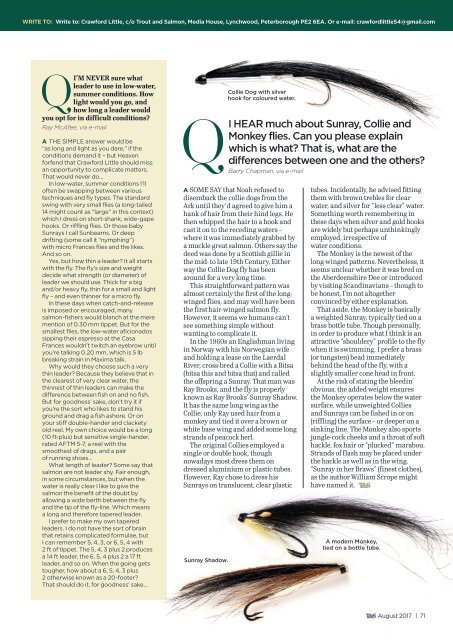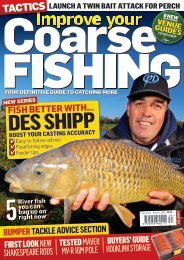Create successful ePaper yourself
Turn your PDF publications into a flip-book with our unique Google optimized e-Paper software.
WRITE TO: Write to: Crawford Little, c/o <strong>Trout</strong> <strong>and</strong> <strong>Salmon</strong>, Media House, Lynchwood, Peterborough PE2 6EA. Or e-mail: crawfordlittle54@gmail.com<br />
QI’M NEVER sure what<br />
leader to use in low-water,<br />
summer conditions. How<br />
light would you go, <strong>and</strong><br />
how long a leader would<br />
you opt for in difficult conditions?<br />
Ray McAfee, via e-mail<br />
A THE SIMPLE answer would be<br />
“as long <strong>and</strong> light as you dare,” if the<br />
conditions dem<strong>and</strong> it – but Heaven<br />
forfend that Crawford Little should miss<br />
an opportunity to complicate matters.<br />
That would never do…<br />
In low-water, summer conditions I’ll<br />
often be swapping between various<br />
techniques <strong>and</strong> fly types. The st<strong>and</strong>ard<br />
swing with very small flies (a long-tailed<br />
14 might count as “large” in this context)<br />
which I dress on short-shank, wide-gape<br />
hooks. Or riffling flies. Or those baby<br />
Sunrays I call Sunbeams. Or deep<br />
drifting (some call it “nymphing”)<br />
with micro Frances flies <strong>and</strong> the likes.<br />
And so on.<br />
Yes, but how thin a leader? It all starts<br />
with the fly. The fly’s size <strong>and</strong> weight<br />
decide what strength (or diameter) of<br />
leader we should use. Thick for a big<br />
<strong>and</strong>/or heavy fly, thin for a small <strong>and</strong> light<br />
fly – <strong>and</strong> even thinner for a micro fly.<br />
In these days when catch-<strong>and</strong>-release<br />
is imposed or encouraged, many<br />
salmon-fishers would blanch at the mere<br />
mention of 0.30 mm tippet. But for the<br />
smallest flies, the low-water aficionados<br />
sipping their espresso at the Casa<br />
Frances wouldn’t twitch an eyebrow until<br />
you’re talking 0.20 mm, which is 5 lb<br />
breaking strain in Maxima talk.<br />
Why would they choose such a very<br />
thin leader? Because they believe that in<br />
the clearest of very clear water, the<br />
thinnest of thin leaders can make the<br />
difference between fish on <strong>and</strong> no fish.<br />
But for goodness’ sake, don’t try it if<br />
you’re the sort who likes to st<strong>and</strong> his<br />
ground <strong>and</strong> drag a fish ashore. Or on<br />
your stiff double-h<strong>and</strong>er <strong>and</strong> clackety<br />
old reel. My own choice would be a long<br />
(10 ft-plus) but sensitive single-h<strong>and</strong>er,<br />
rated AFTM 5-7, a reel with the<br />
smoothest of drags, <strong>and</strong> a pair<br />
of running shoes…<br />
What length of leader? Some say that<br />
salmon are not leader shy. Fair enough,<br />
in some circumstances, but when the<br />
water is really clear I like to give the<br />
salmon the benefit of the doubt by<br />
allowing a wide berth between the fly<br />
<strong>and</strong> the tip of the fly-line. Which means<br />
a long <strong>and</strong> therefore tapered leader.<br />
I prefer to make my own tapered<br />
leaders. I do not have the sort of brain<br />
that retains complicated formulae, but<br />
I can remember 5, 4, 3, or 6, 5, 4 with<br />
2 ft of tippet. The 5, 4, 3 plus 2 produces<br />
a 14 ft leader, the 6, 5, 4 plus 2 a 17 ft<br />
leader, <strong>and</strong> so on. When the going gets<br />
tougher, how about a 6, 5, 4, 3 plus<br />
2 otherwise known as a 20-footer?<br />
That should do it, for goodness’ sake…<br />
Q<br />
I<br />
HEAR much about Sunray, Collie <strong>and</strong><br />
Monkey flies. Can you please explain<br />
which is what? That is, what are the<br />
differences between one <strong>and</strong> the others?<br />
Barry Chapman, via e-mail<br />
A SOME SAY that Noah refused to<br />
disembark the collie dogs from the<br />
Ark until they’d agreed to give him a<br />
hank of hair from their hind legs. He<br />
then whipped the hair to a hook <strong>and</strong><br />
cast it on to the receding waters –<br />
where it was immediately grabbed by<br />
a muckle great salmon. Others say the<br />
deed was done by a Scottish gillie in<br />
the mid- to late 19th Century. Either<br />
way the Collie Dog fly has been<br />
around for a very long time.<br />
This straightforward pattern was<br />
almost certainly the first of the longwinged<br />
flies, <strong>and</strong> may well have been<br />
the first hair-winged salmon fly.<br />
However, it seems we humans can’t<br />
see something simple without<br />
wanting to complicate it.<br />
In the 1960s an Englishman living<br />
in Norway with his Norwegian wife<br />
<strong>and</strong> holding a lease on the Laerdal<br />
River, cross-bred a Collie with a Bitsa<br />
(bitsa this <strong>and</strong> bitsa that) <strong>and</strong> called<br />
the offspring a Sunray. That man was<br />
Ray Brooks, <strong>and</strong> the fly is properly<br />
known as Ray Brooks’ Sunray Shadow.<br />
It has the same long wing as the<br />
Collie, only Ray used hair from a<br />
monkey <strong>and</strong> tied it over a brown or<br />
white base wing <strong>and</strong> added some long<br />
str<strong>and</strong>s of peacock herl.<br />
The original Collies employed a<br />
single or double hook, though<br />
nowadays most dress them on<br />
dressed aluminium or plastic tubes.<br />
However, Ray chose to dress his<br />
Sunrays on translucent, clear plastic<br />
Sunray Shadow.<br />
Collie Dog with silver<br />
hook for coloured water.<br />
tubes. Incidentally, he advised fitting<br />
them with brown trebles for clear<br />
water, <strong>and</strong> silver for “less clear” water.<br />
Something worth remembering in<br />
these days when silver <strong>and</strong> gold hooks<br />
are widely but perhaps unthinkingly<br />
employed, irrespective of<br />
water conditions.<br />
The Monkey is the newest of the<br />
long-winged patterns. Nevertheless, it<br />
seems unclear whether it was bred on<br />
the Aberdeenshire Dee or introduced<br />
by visiting Sc<strong>and</strong>inavians – though to<br />
be honest, I’m not altogether<br />
convinced by either explanation.<br />
That aside, the Monkey is basically<br />
a weighted Sunray, typically tied on a<br />
brass bottle tube. Though personally,<br />
in order to produce what I think is an<br />
attractive “shouldery” profile to the fly<br />
when it is swimming, I prefer a brass<br />
(or tungsten) bead immediately<br />
behind the head of the fly, with a<br />
slightly smaller cone head in front.<br />
At the risk of stating the bleedin’<br />
obvious, the added weight ensures<br />
the Monkey operates below the water<br />
surface, while unweighted Collies<br />
<strong>and</strong> Sunrays can be fished in or on<br />
(riffling) the surface – or deeper on a<br />
sinking line. The Monkey also sports<br />
jungle-cock cheeks <strong>and</strong> a throat of soft<br />
hackle, fox hair or “plucked” marabou.<br />
Str<strong>and</strong>s of flash may be placed under<br />
the hackle as well as in the wing.<br />
“Sunray in her Braws” (finest clothes),<br />
as the author William Scrope might<br />
have named it.<br />
A modern Monkey,<br />
tied on a bottle tube.<br />
August 2017 | 71

















